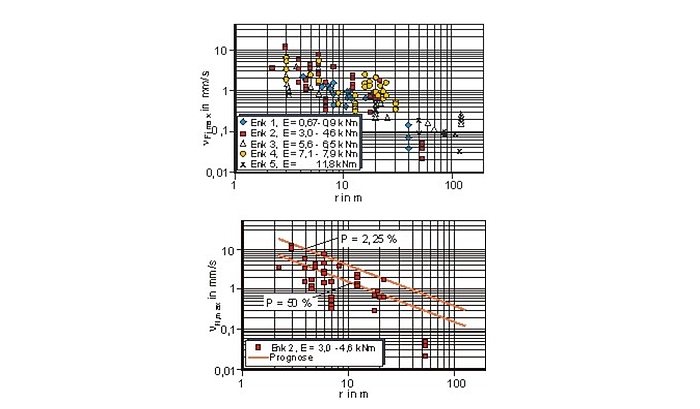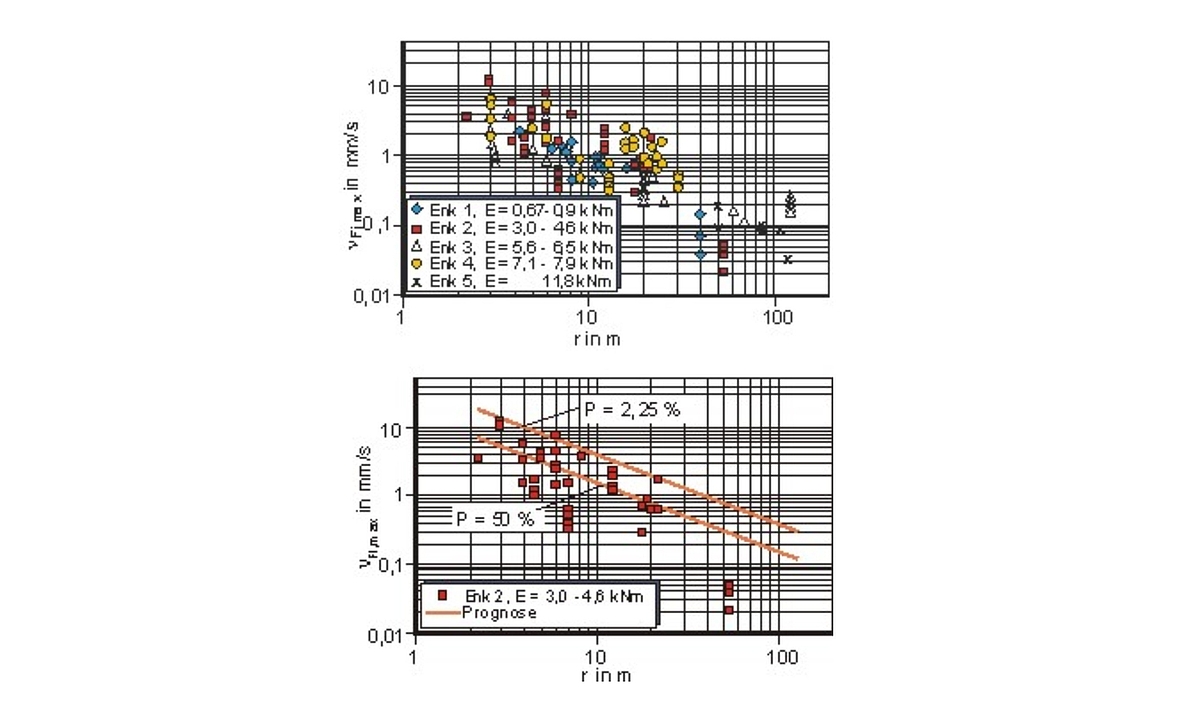Building vibrations due to ground works
Prof. Dr.-Ing. Martin Achmus / Dipl.-Ing. Florian tom Wörden
Introduction



In many ground work measures, for instance pile driving, vibratory driving of sheet piles or vibratory compaction of non-cohesive soils, dynamic forces are acting on the subsoil. The arising vibrations are transmitted through the subsoil to adjacent buildings and can there, dependent on the intensity of vibrations, cause damages.



In the scope of the planning process, the vibration effects should be estimated and the ground work machines have to be chosen in a way that the effect on adjacent buildings is avoided or at least minimized. In the scope of a research project, the results of vibration measurements were evaluated in order to develop equations to prognosticate the intensity of vibrations. As an example, in Fig. 2 measured vibration values during vibration of piles or sheet piles are presented. 155 measurement series have been assessed for that. The measured maximum vibration velocities are given dependent on the distance r of the foundation from the location of vibration. The lines also given in Fig. 2 are the result of a linear regression analysis, assuming the following type of prognosis:



Here E is the maximum vibration energy per vibration period, which can be calculated with the maximum machine power W and the vibration frequency f by E = W/f.
The equation given was found to be suitable to prognosticate foundation vibration velocities due to vibratory driving works. To obtain the K-value needed for the prognosis, the vibration machines were divided into five energy classes. The evaluation then yields K-values, which can be derived for different probabilities of exceedance. For vibratory driving a K-value of 7.9 was found for a 50% probability of exceedance and of 18.52 for a 2.25% probability of exceedance.



Totally 550 measurement series were assessed, which were done during driving and vibratory compaction measures. As a result of the analyses the equations given in Table 1 for the foundation vibration velocities are recommended for use in the scope of a vibration prognosis. With these equations, the vibration intensity of the building foundation is obtained directly. A probable value (average value, 50 % probability of exceedance) and a unfavourable value (2.25 % probability of exceedance) are distinguished. The vibration velocities forecasted with the equations given in Table 1 can form the basis of an evaluation of damage risk.
Publications
[1] Achmus, M., Kaiser, J., tom Wörden, F. (2004). Bauwerkserschütterungen durch Tiefbauarbeiten. Bericht 20 der Informationsreihe des Instituts für Bauforschung e. V., Hannover
[2] Achmus, M., Kaiser, J., tom Wörden, F. (2005). Bauwerkserschütterungen durch Tiefbauarbeiten. Mitteilungen des Instituts für Grundbau, Bodenmechanik und Energiewasserbau der Universität Hannover, Heft 61.
[3] Achmus, M. (2006). Prognosen für das Fernfeld -Ein praktischer Leitfaden hilft den Ingenieuren bei Erschütterungsproblemen. Deutsches Ingenieurblatt (DIB), Heft 4
[4] Achmus, M., Kaiser, J. (2006). Prognose von Bauwerkserschütterungen infolge Ramm- und Vibrationsverdichtungsarbeiten. XIII. Donau-Europäische Konferenz, Ljubljana
[5] Achmus, M. (2006). Gebäudeschäden infolge Erschütterungseinwirkungen aus Tiefbauarbeiten. 41. Bausachverständigentag Schäden an erdberührten Bauteilen, Frankfurt.
[6] Achmus, M. (2007). Schadensrisikobeurteilung für Erschütterungseinwirkungen aus Tiefbauarbeiten. Buchbeitrag in: Bauschäden im Hoch- und Tiefbau, Teil 2: Tiefbau, Hrsg. V. Rizkallah, Fraunhofer IRB Verlag, Stuttgart (in Vorbereitung).
[7] Achmus, M. Wehr, J., Spannhoff, T. (2007). Untersuchung zu Bauwerks- und Bodenerschütterungen infolge Tiefenrüttlung. (In Vorbereitung).














